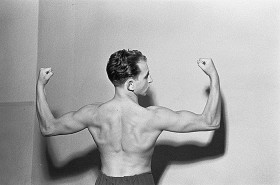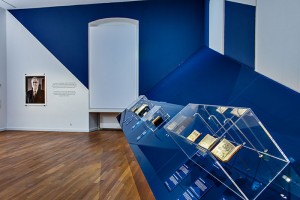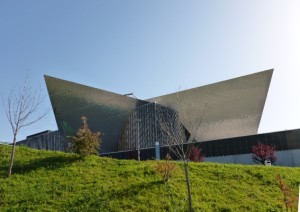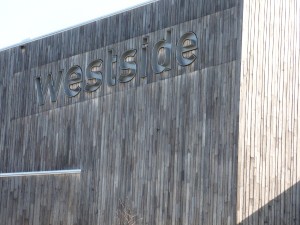At the Second Zionist Conference on 28 August 1898 in Basel, Switzerland, Max Nordau dedicated a passionate speech to the subject of muscular Judaism. The doctor, publicist and co-founder of the young Zionist movement said:

Herbert Sonnenfeld: Boxer portrait, Berlin 1935
© Jewish Museum Berlin, purchased with funds provided by Stiftung DKLB
“Zionism breathes new life into Judaism. This much I am sure of. It does this morally by refreshing the ideals of the People, physically by the physical education of our offspring, who shall reestablish a bygone muscular Judaism.”
This should therefore not only replace the widespread image of the weak Jew but also support the creation of a new, physically strong “Judaism.” It didn’t take long for this to be realized: just three months following Nordau’s address, the first Jewish sports association was founded in Berlin. It was named Bar Kokhba, after the leader of Judean Jewish resistance against Rome from 132-135 ACE. In a report titled, “Muscular Judaism,” for the new association newspaper, Jüdische Turnzeitung, Nordau described it as the “last, globally historic embodiment of a battle-hardened, weapon-ready Judaism.” He called on Jews to “connect with our oldest traditions: (Then) we’ll again be broad-chested, strong armed, bold-looking men.” → continue reading
An Interview with René Braginsky
When did you start collecting and how large is your collection?
René Braginsky: I started collecting books more than twenty years ago. It was my son’s Bar Mitzvah, and I was looking for an illustrated blessing for the celebration. Since I could not find one, we made do with a copy. For his wedding, however, we were able to reproduce a blessing from our own collection. As I slowly acquired a taste for collecting, I bought more objects, and of increasingly quality, whenever possible. A good friend of mine, an older collector, encouraged me. The Judaica collection now comprises more than 700 pieces: books mainly, but also illustrated wedding contracts and Esther scrolls.
What motivates you to collect Hebrew manuscripts? Do you collect with a specific objective or mission in view?

Interior view of the special exhibition “The Creation of the World. Illustrated Manuscripts from the Braginsky Collection” © Jewish Museum Berlin, photo: Martin Adam
I’m interested, first and foremost, in the direct connection with Jewish history, with my view of Jewish history. I find the sheer variety of illustrations fascinating, as well as the regional and national influences they display. Jewish books in Germany are primarily German books, just as Jewish books from Spain are primarily Spanish and those from Morocco Moroccan. Jews lived in diverse regions, in a diaspora, and the illustrations in the books reflect this. And these old books so full of erudition bring me peace and make me confident, too, that whatever is really important will always survive. The mission, if there is such a thing, is my wish to share them freely, instead of hiding these treasures from the world. That is why we published websites (braginskycollection.com und braginskycollection.ch) , put two iPad apps online (Braginsky Collection und Braginsky Collection Berlin) and chose to exhibit a part of our collection in Berlin, for the fifth time. Over the years, the exhibitions and online sources have enabled tens of thousands of people all over the world—Jews and non-Jews —to share our enjoyment of the collection.
Do you believe the market for collectors of Judaica and Hebrew manuscripts has changed over the last few decades? Have you come across any counterfeiters or crooked dealers? → continue reading
 For enthusiasts of the Jewish Museum, excursions to other Libeskind buildings are imperative. Many are thematically related to the JMB, such as the Felix-Nussbaum-Haus in Osnabrück or the Jewish Museum in San Francisco. But equally worthwhile are the buildings designed for entirely other purposes, such as Westside, a suburban shopping mall completed in 2008 over a highway outside of Berne, Switzerland.
For enthusiasts of the Jewish Museum, excursions to other Libeskind buildings are imperative. Many are thematically related to the JMB, such as the Felix-Nussbaum-Haus in Osnabrück or the Jewish Museum in San Francisco. But equally worthwhile are the buildings designed for entirely other purposes, such as Westside, a suburban shopping mall completed in 2008 over a highway outside of Berne, Switzerland.
 The mall – despite, well, being a mall – shares many features with the Jewish Museum, which was Libeskind’s first building project. The well-trained, or perhaps overly-trained, eye may involuntarily pick up on architectural testimonies to German-Jewish history. → continue reading
The mall – despite, well, being a mall – shares many features with the Jewish Museum, which was Libeskind’s first building project. The well-trained, or perhaps overly-trained, eye may involuntarily pick up on architectural testimonies to German-Jewish history. → continue reading



